Businesses in 1929. Businesses in 1929. Businesses in 1929. Businesses in 1929. Businesses in 1929.
In 1929 The Great Southern Herald produced a “Centenary Publication” to celebrate Australia’s centennial year. Although concentrating on Katanning it also included information about Kojonup, Broomehill, Tambellup, Woodanilling, Nyabing and Pingrup. The publication was compiled and printed at its Austral Terrace premises. Part of the publication also included photographs and information about various businesses in Katanning… early ‘advertorials’.
These are those stories…
…In the words of the journalists of the day
A. NEWBEY & CO.
Show Rooms, Austral Terrace.
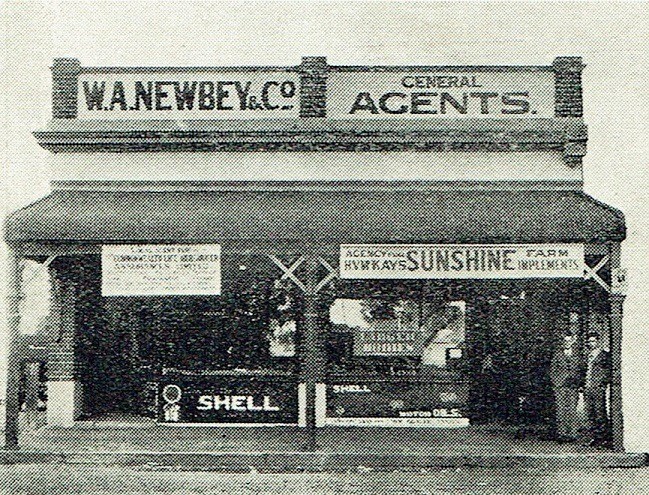
Before transferring his activities to Katanning, Mr. W. A. Newbey was engaged in the breeding of high-class Merino sheep on the well-known “Alton Park” property, some miles out of Kojonup. In 1928 he sold his rural interests and transferred to Katanning, where he purchased the business of Mains Limited. He launched his business at the commencement of 1929 with his sons Harold and Alfred, trading under the name of W. A. Newbey and Company.
Equipped with a first-hand knowledge of the needs of the man on the land, Mr. W. A. Newbey managed the business and handled the important lines of Messrs. H. V. McKay’s “Sunshine” farm and station machinery, in addition to the agency for Cletrac Tractors, the Southern Union and General Fire Insurance Limited, the Commonwealth Life Amalgamation Insurance Limited, and a Land and Estate Agency of his own.
Mr. R. A. Newbey, who has separate showrooms in Clive Street, is the local dealer for Whippet, Willys-Knight, Falcon and Stearns Knight cars, and Whippet, Willys-Knight and Manchester trucks, Rex Acme, Levis and Norton motor cycles, Rapson tyres, Castrol oils and car accessories. He is the local agent for the Ocean Accident and Guarantee Corporation and Commonwealth Life Insurance.
DAVEY’S SHOE STORE.
Premises, Clive Street.
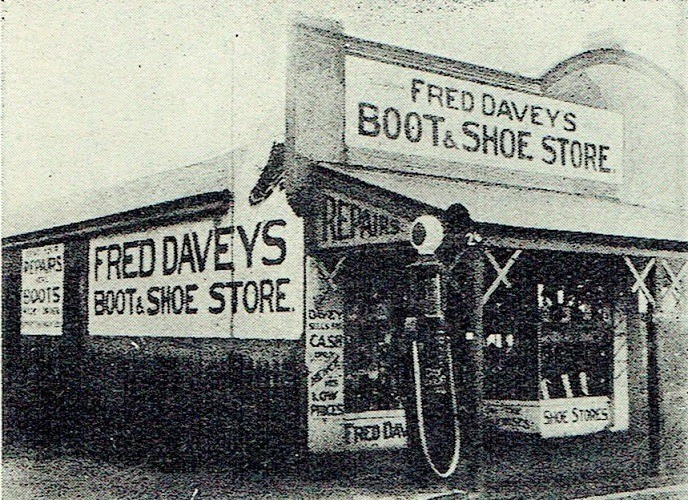
Mr. Fred Davey, the proprietor of Davey’s Shoe Stores, Clive Street, Katanning, arrived in this town in January, 1927, with a good knowledge of the intricacies of the footwear trade, having resigned from the position of branch manager of Ezywalkins, of Perth, to launch out in the retail business.
Within a short time he had attracted the notice of the townspeople by his up-to-the-minute stocks, and, being the only business man dealing exclusively in footwear, was able to make ‘a close study of local requirements. Mr. Davey stocks all the latest in footwear and imports from all the leading factories of the Commonwealth. He personally attends to male customers, while his wife, who has been connected with the boot trade for the past 20 years, is in charge of the ladies’ department and buys all the stocks for this branch of the business.
Adjoining the showroom is a boot and shoe repairing department with the latest electric machinery installed, from which all types of repairs are turned out expeditiously by an experienced workman.
In private life Mr. Fred Davey is Chairman of the Austral Football Club, Secretary of the local Cricket Association, a Vice-President of the Cycle Club, a Vice-President of the Hockey Association, and a Trustee of the local Football Accident Fund.
BANK OF NEW SOUTH WALES.
Katanning Branch.
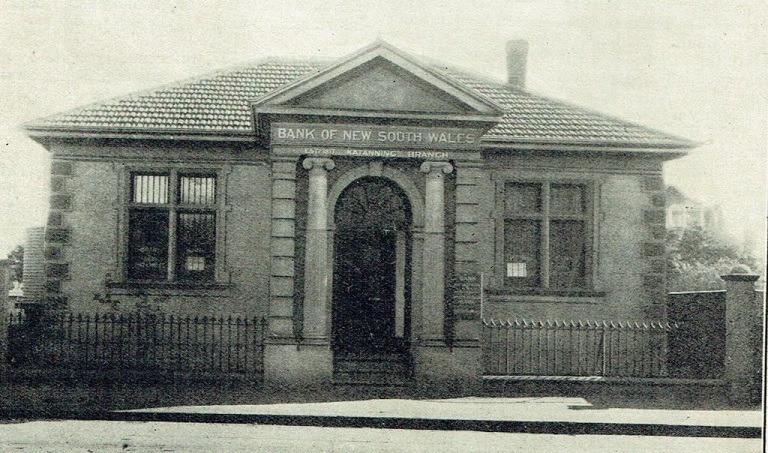
The Bank of New South Wales, which in 1927 amalgamated with the Western Australian Bank, opened at Katanning in 1910, and for a number of years occupied small wooden premises in Albion Street, the business being conducted by a manager and assistant.
At this time the town of Katanning and the surrounding districts were rapidly coming to the fore, and it was not long before the young branch grew to such an extent that a removal was made to more commodious quarters in Austral Terrace, owned by the Estate of the late F. H. Piesse.
By 1921 the prestige of the institution had been firmly established, and the Directors demonstrated their faith in the town and district by purchasing a block of land opposite the Katanning Flour Mills in Argent Street, on which was erected the handsome bank building, with manager’s residence attached, shown in the illustration.
In March of 1927 came the amalgamation of the New South Wales and West Australian Banks, two of the leading financial institutions of the State, Mr. J. H. Calman, former manager of the New South Wales Bank, taking control of the combined business with a staff of six under his jurisdiction. In the Katanning Electorate there are now branches at Kojonup, Tambellup and Gnowangerup, and a weekly Agency at Pingrup.
The Bank of New South Wales first started in Sydney in 1817, and has since spread to all the States, in addition to New Zealand, Fiji, Papua, and the Mandated Territories of New Guinea. The W.A. Bank was founded at Perth (W.A.) in 1841, and after overcoming all the difficulties experienced by a young financial institution, spread to all parts of the State.
Since the amalgamation, the Bank of New South Wales has the largest banking business in the State.
Its paid-up capital is £7,500,000, Reserve Fund £5,900,000, and Reserve Liability of Proprietors 17,500,000, making a total of £20,900,000. The Bank’s total assets on September 30 of 1928 were £88,982,585.
W.P. BIRD – TAILORS

Mr. W. P. Bird was born in Benalla, Victoria, better known as the Kelly Country, to which district his parents moved shortly after his birth at Wangaratta. He entered the tailoring trade at an early age, and was instructed by his father, who came from a family which had made tailoring its means of livelihood for many years.
Mr. Bird came to Western Australia and started in business on the Goldfields. He then moved to Katanning, where he opened on April 26, 1909, in a small rented room later occupied by Dr. E. C. Pope for his surgery. His first order for a suit was from Mr. Cecil Piesse.
In 1912, owing to expansion of business, he moved to Austral Buildings with a staff of one man and four girls and from this time his business continued to prosper. The business improved to such an extent that further expansion was found necessary in 1928, when with a staff of 12, he purchased his own premises on the corner of Clive and Taylor Streets.
The. extra room gave Mr. Bird facilities to launch out more extensively in all lines of haberdashery, and his stocks would compare favourably with any similar business in the city.
Mr. Bird was recognised as the leading country tailor of the State, and with his handsome new premises, a branch at Kojonup and a highly trained staff undoubtedly held pride of place in the tailoring business of the district.
F. WANKE,
General Merchant.
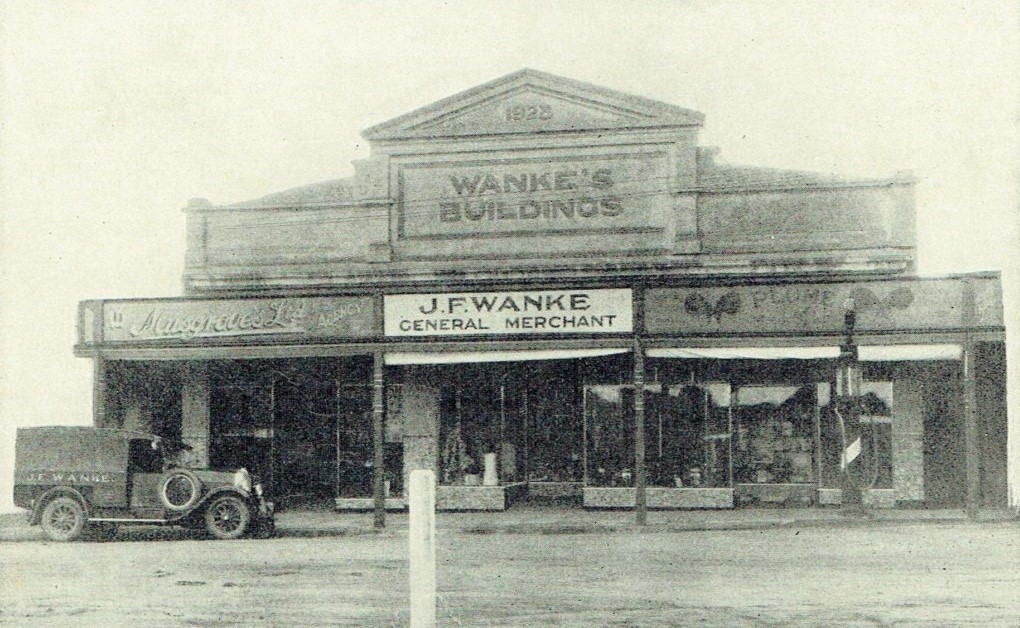
Mr. John F. Wanke started his business career with the firm of W. J. Rogers & Sons in 1902, and after remaining there for eight years disposed of an interest he held in that firm to launch out on his own. His business was founded in a small shop 14ft. x 20ft. on the site of his present fine emporium in Clive Street, and for some time he dealt exclusively in groceries.
Within a space of twelve months the operations had grown to such an extent that the foundation premises were inadequate to cope with the increasing stocks and the building was enlarged. Two years later a drapery department was added, and rapidly gained prestige in the town. Further evidence of expansion came three years later, when the premises were extended rearwards, to make room for the ever-increasing volume of business.
In 1928 the premises were completely redesigned. The old wooden frontage, including an adjoining shop which had been leased to a tenant, was completely demolished, and replaced by one of the most attractive shop fronts outside the metropolitan area. Two windows and a special department were devoted to the display of the musical lines of Messrs. Musgroves’ (Perth) warehouse, for which Mr. Wanke is the local agent, while five large show windows and an island window, the first in the town, were devoted to the display of the varied lines stocked.
The base of the windows was lined with marble tiles similar in design to those used by business firms on the famous Broadway of New York (U.S.A.) and surmounted by bars of highly polished steel. Two doors of bevelled glass similar in design to those installed in Hoyt’s Theatre, Perth, formed entrance to the establishment, the whole structure enhancing the beauty of Clive Street.
Since that time Mr. Wanke has improved his stocks to bring them into line with the inviting exterior of the shop, and has increased his staff to cope with the extra business which the recent improvements attracted. His latest move with the times is the purchase of an up-to-date delivery van for the convenience of country customers. As he now lives on the premises, the owner has instituted a day and night petrol and oil service, served from a pump in front of the shop.
KATANNING STOCK & TRADING
CO LTD
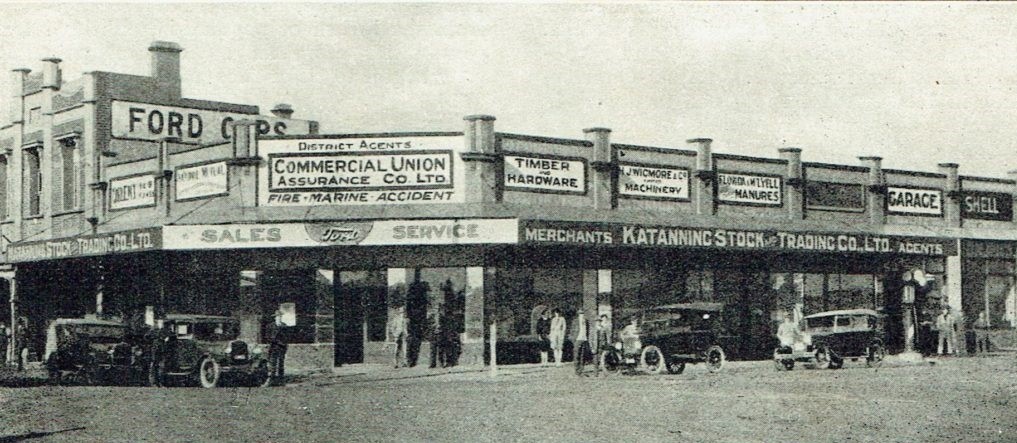
To trace the foundation of the Katanning Stock & Trading Company Limited, it is necessary to go back twenty-four years, when the present business, then known as A E. Piesse & Company, was established in Austral Terrace, with offices and a small showroom.
The timber yards were located on the corner of the building at the intersection of Albion Street, and the business was carried on with a staff of three – Messrs. A. E. Piesse, F. M. Gare and an assistant, Mr. Maley Chipper. The firm traded extensively in farm and building requirements, but three years later (1908) embraced livestock dealing in its activities.
This branch of the business was placed under the charge of Mr. T. W. Langley, and the first regular monthly sheep sales in the district were instituted.
During the same year the firm was transformed into a limited liability company, trading henceforth under the name of The Katanning Stock & Trading Company Limited, the Directors being Messrs. A. E. Piesse, F. L. Holly and George McLeod, with Mr. F. M. Gare as Secretary. In 1914 the livestock portion of the business was disposed of, and two notable agencies in the form of The Ford Motor Car and the Agricultural Machinery lines of Messrs. H. J. Wigmore & Co. Ltd. were added.
The most important event of the firm’s history occurred in 1925, when it was found necessary to erect new premises to cope with the rapidly increasing trade. One of the most modern and handsome showrooms outside Perth was built on the site of the old timber yards, together with an up-to-date Ford Service Station and Garage, with a floor space of 12,500 feet.
Located right opposite the Katanning Railway Station, with its brightly illuminated windows the new building has greatly enhanced the appearance of the town and indicates the prosperity of the district to all new-corners as they enter Austral Terrace.
The chief agencies at present are:
Millar’s Timber & Trading Co. Ltd., which includes a full range of building material, timbers, asbestos sheet and ceiloyd; H. J. Wigmore & Co. Ltd., agricultural machinery, fertilisers, jute goods; Orient Line of Royal Mail Steamers; West Australian Airways Limited; The Commercial Union Assurance Co. Ltd.; The National Mutual Life Association of Australasia Ltd.; The Ford Motor Company of Australia Pty. Ltd., motor cars, trucks and tractors. In connection with this agency a well-equipped garage WAS established, with petrol pumps and battery service station. With a most complete spare parts department, the Service Station is equal to anything outside of the city.
Mr. F. M. Gare, J.P., who was appointed Manager in 1913, still guides the destinies of the firm and was added to the Directorate this year. Mr. A. J. Morrell is the Company’s Secretary, under the Directorate of Messrs A. F. Piesse, J.P., H. V. Piesse, A. G. Purkiss and F. M. Gare, J.P.
CHURCH OF ENGLAND
KOBEELYA GIRLS’ SCHOOL
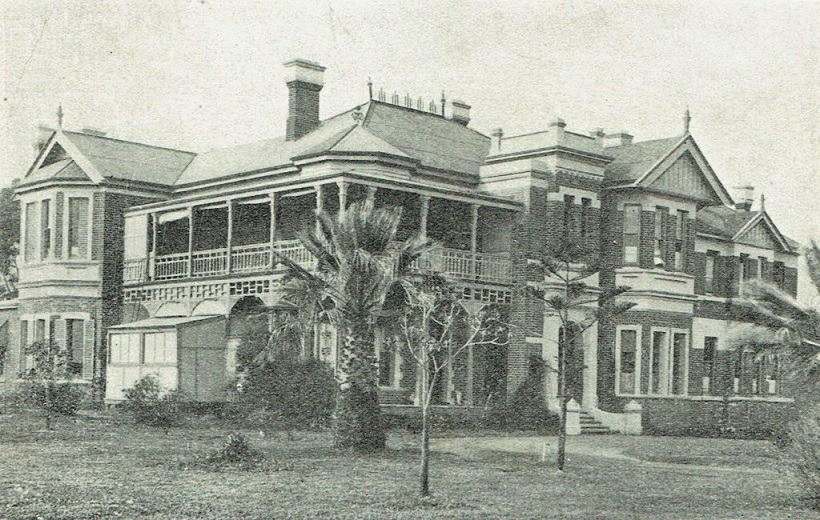
“Kobeelya”, a fine two-storied building, was originally the home of the late Hon. F. H. Piesse. It is situated on rising ground about a mile from the centre of the town, with a wide outlook over the surrounding country, and immediately behind it lie the Katanning golf links.
The school had its beginning in 1917, when a small kindergarten was opened by Mrs. Burbidge, M.A., in the Parish Hall, and five children were enrolled. By 1920 the number of both boarders and day-pupils had increased to such an extent that a wood building comprising two school-rooms and a sleeping-out verandah was erected with the help of friends. Two years later all available room in both Rectory and school building was occupied.
A representative meeting of parents and friends was called, and it was decided to form a Company with the object of purchasing “Kobeelya” and opening permanent premises. This was done, and in September, 1922, the Archbishop of Perth, in the absence of the Bishop of Bunbury, came to Katanning and formally declared “Kobeelya” open. The pupils at the time numbered twenty-two, seventeen of them being boarders.
As the numbers increased the necessary class-rooms and dormitories have been added, as well as six specially designed sound-proof practicing rooms for the music pupils. The grounds comprise fifty acres. The school has its own nine-hole golf course, five tennis courts, and hockey and net-ball grounds. A fund is already in hand towards the erection of a school chapel in the near future.
The enrolment of pupils is limited to seventy boarders and fifteen day-pupils. There are two matrons, in addition to a teaching staff of nine. The school curriculum has been designed to cover all the stages of a girl’s education from the kindergarten to the University Leaving Certificate.
KATANNING
BOY’S GRAMMAR SCHOOL
“The Bungalow”
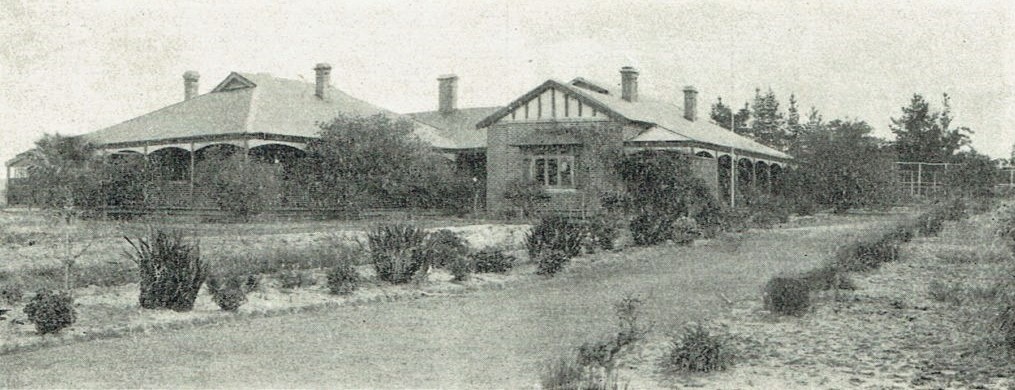
The Katanning Grammar School was established in May, 1929, the Centenary year of the State, as a preparatory school for boys up to the age of fourteen years, and although still in its infancy, has met with most encouraging success.
The project was financed by the formation of a company known as Katanning Grammar School Limited, the shareholders of which are practically all local residents. By this means the fine property at Katanning of Dr. F. M. House was purchased for the purposes of a school. The original intention of the directors had been to obtain sufficient capital to build school premises, but as this would have entailed considerable delay, and the fact that “The Bungalow” became available, decided them to acquire the property and open the school as soon as possible.
The initial work in connection with the flotation of the company was borne by a board of provisional directors, comprising Messrs. A. F. Watts (chairman), M. Balston, C. F. Cockram, P. H. Crossley, L. C. Rae, I. L. Richardson and I. Synnott, who, with the aid of Mr. E. G. Brinkley as canvasser, met with a gratifying response in respect to the sale of shares.
The tragic end of Mr. Brink1ey through a motor-accident, together with the death of Mr. Richardson, who succumbed to illness, are to be recorded as a very serious loss to the project in its early stages. At the first annual meeting of shareholders of the company, when the present board of directors was elected, Messrs. Cockram and Crossley declined to re-nominate owing to the distance at which they lived from town preventing them from giving the necessary attention to the affairs of the company.
The school was fortunate in obtaining as Headmaster Mr. Matthew Wilson, B.A., who for a number of years was Headmaster at the Perth High School, and who is particularly qualified to guide the destinies of the young school at Katanning. Mrs. Wilson has made it her charge to care for the welfare of boarders.
“The Bungalow” is a modern residence of seventeen main rooms, standing in its own grounds of nearly six acres, and its situation at one of the highest points within the town makes it an ideal school building. Katanning itself is over 1,000 feet above sea level and has a climate unequalled in the State, everything, therefore, lending itself to assure the success of this school.
The affairs of the company are managed by a Board of Directors, the personnel being Messrs. A. F. Watts (Chairman), H. V. Piesse, M. Balston, L. C. Rae, I. Synnott, N. Anderson and J. Stodart, with Mr. Richard Cobham as secretary, from whom all particulars may be obtained by persons interested, in this promising scholastic establishment.
THE NATIONAL BANK
of AUSTRALASIA LTD.
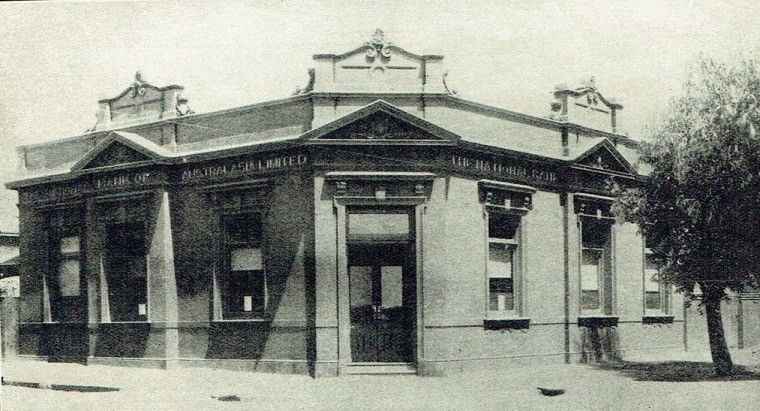
On January 2, 1902, a branch of the National Bank of Australasia Limited was opened in Piesse’s Buildings, Austral Terrace, Katanning, by Mr. John Anderson, the first manager.
Even at such an early date the town was rapidly gaining prestige, and by 1904 the young branch had progressed to such an extent that new premises were authorised by Head Office, and accordingly a handsome building appeared on the corner of Austral Terrace and Argent Street. Since that time the structure has been considerably added to, but the central site is still retained.
From January of 1902 to March of 1903 agencies of the Katanning Branch were conducted at Narrogin and Wagin, these offices then being converted to full Branch status. In September of 1903 an agency was opened at Broomehill, and two years later was transformed to a Branch, but in March of 1916, due to its proximity to Katanning, this office was closed. Branches were established at Kojonup in 1906 and at Gnowangerup in 1910, while a Receiving Office of the Katanning Branch was opened in March of 1914 at Woodanilling. It will thus be seen that the National Bank for the past 27 years has been closely associated with the Katanning and surrounding districts and has played its part in financing the development of these regions.
Mr. Anderson, the foundation manager, remained in charge of the Katanning Branch until July of 1907, when he was succeeded by Mr. R. A. Strachan, whose successors were F. A. Langley, J. A. McDonald, T. J. Jones, and L. G. A. Rutter, the latter still controlling the destinies of the Bank in this town.
The National Bank at the present time has, in addition to its Perth Office, two city branches, six suburban branches, and 38 country branches, together with four agencies and 24 receiving offices, making a total in Western Australia of 75 offices. Throughout Australia its offices number 490. Agencies have been appointed in most capital cities of the world, and two offices function in London. Paid-up capital amounts to £5,000,000. Funds total £3,100,000, and total Assets exceed £47,000,000.
THE UNION BANK
OF AUSTRALIA LIMITED
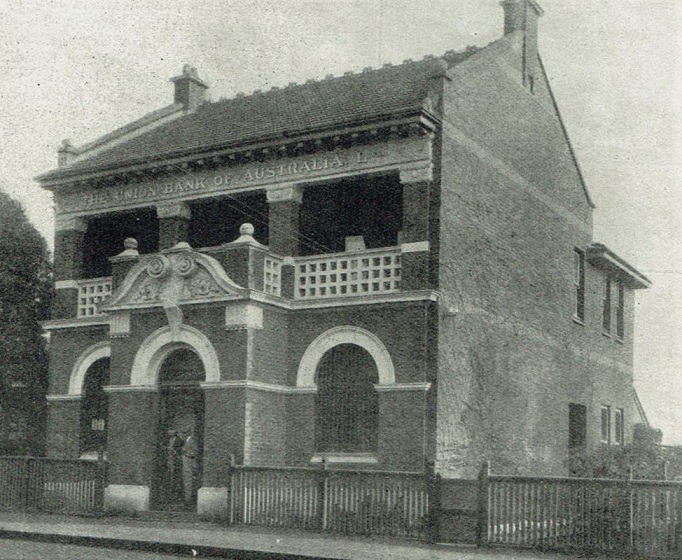
The Union Bank of Australia Limited was established in London in 1837, and was incorporated in 1880. It opened its first branch in Australia in Launceston in 1839, when the Bank’s paid-up capital was £143,972.
At present there are 214 branches (excluding agencies) throughout Australia and New Zealand open for the transaction of every description of banking business. The first branch in Western Australia was opened in Perth in 1878. At present business in the State is conducted at, in all, 24 branches and one agency.
The branch in Katanning was opened on 23rd December, 1904, by the present Manager, Mr. N. J. C. Treleaven, who came from Adelaide and who has the unique experience of a quarter of a century’s service in one town. He is doubtless largely responsible for the very important position now held by the Bank in Katanning, which has in a large measure assisted in the growth and development of both town and district.
Associated with Mr. Treleaven in his direction of the Bank’s operations at Katanning from time to time have been Messrs. G. I. Hadley (1904 to 1906), W. P. Coyne (1907 to 1917 – now Manager at Kalgoorlie), G. W. Speak (1917 to 1929 – now Manager at Corrigin), and P. A. L. McDowell, present Accountant.
The first customers of the local branch were Mr. Ross Anderson, of “Illareen”, and the late Mr. Thomas Anderson, of “Condeena”, who both arrived in Katanning on the same day as Mr. Treleaven. The existing large and handsome building, which is one of the chief architectural structures of the town, was erected in 1911. It embraces a large Banking Chamber, Manager’s Room and Strongroom, as well as a commodious private residence for the Manager and his family.
KATANNING MOTOR GARAGE
AND ENGINEERING WORKS.
H. W. & J. Mouritz
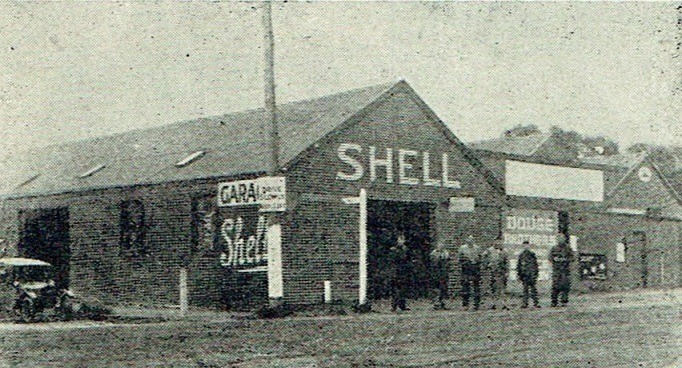
Mr. J. G. Mouritz, J.P., started out in business in 1907, establishing coach-building, engineering and implement works in Argent Street.
Some years later, when the use of motor cars became more universal, and following a disastrous fire in which the original premises were destroyed, Mr. Mouritz went into partnership with his brothers Hugh and William.
A large building was constructed on the western end of the property and the firm undertook general engineering and motor work under the style of H. W. and J. Mouritz.
A few years later Mr. J. Mouritz purchased the business outright and went in extensively for motor repair work and general engineering. To keep pace with the times, vulcanizing, oxy-welding plants, lathes, screwing machine and other modern machinery were installed, together with a special department for car painting, hood making, body building and repairing. The proprietor has been more than careful in the selection of his staff and retains only proved experts for each branch of the business.
The Katanning Motor Garage and Engineering Works, as the business is now styled, is the approved Dodge and Comet Motors Service Station, though, of course, work is undertaken on any type of car, truck, tractor or machine, in addition to battery servicing, repairing and charging.
The total floor space, including an accessory department, motor and engineering room, trimming and oxy-welding department, and a paint and finishing shop, totals 3,540 square feet. The staff at present numbers six.
RICHARDSON & CO. LTD.
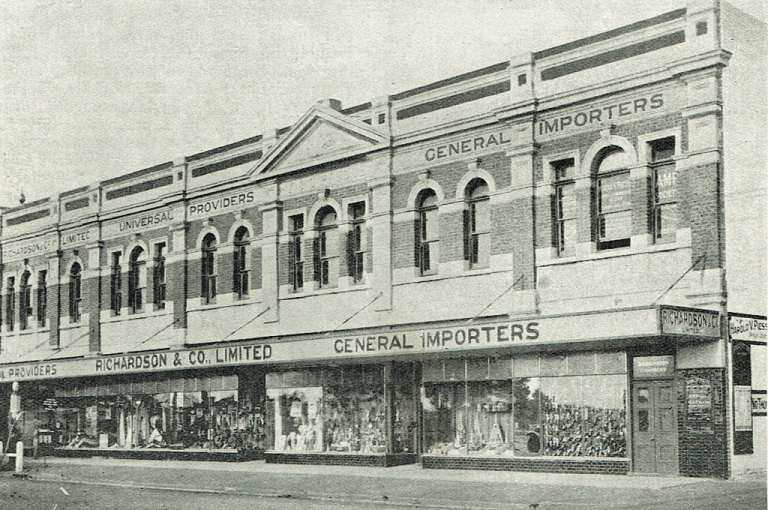
This well-known business house has been intimately connected with the progress of Katanning since its inception.
Established by the late Hon. F. H. Piesse and his brother, the late Hon. C. A. Piesse, in 1898, the first building was an iron shack of one room situated opposite the site of the present Railway Station.
Later, a more commodious wood and iron building was erected in Austral Terrace giving way in 1901 to a modern two-storey brick building with plate-glass front, which was thought to be at least 25 years ahead of requirements. In March, 1904, the late Robert Lawson Richardson entered into partnership with the late Hon. F. H. Piesse and carried on the store-keeping business in the name of Richardson & Co.
Under his wise guidance, not only was a generous measure of assistance rendered to the settlers throughout the district, but very rapid expansion of trade was made. Branches were opened in the various outlying centres, and the people outback were given the full benefit of the complete and varied stocks held at Katanning. A special feature was made of the produce business, the rule of the firm being to purchase FOR CASH at full market rates eggs, butter, and every other farm product.
In 1908 a new wing was added to the Katanning premises, but still the turnover grew and the demand for space increased. In March, 1924, the business was floated into a Limited Company under the present name of Richardson & Company Limited, with the late Mr. R. L. Richardson filling the position of Chairman of Directors. In 1927 the premises at Katanning were purchased from the Estate of the late F. H. Piesse and, in November of the same year, a start was made with extensive additions and alterations which have given the firm the finest Retail Establishment outside the metropolitan area.
The lamented death of Mr. R. L. Richardson in September, 1928, was a severe blow, but Mr. Harold V. Piesse has assumed the duties of Chairman of Directors, and the business is being continued on the same lines which have proved so successful in the course of years.
ROGERS CENTRAL STORES
William J Rogers Ltd.

In the year 1901, before Katanning had become established as an agricultural and wool producing centre, Mr. W. J. Rogers, with a staff of three, launched out in business in Clive Street on part of the site now occupied by the Central Store.
The building, which was less than one-third of the present size, contained two shallow windows, a general shopping department, a small storeroom and office, together with a residential portion at the rear.
Three years later the proprietor purchased from Mr. A. E. Piesse the adjoining vacant block and built thereon the nucleus of the present fine structure. In the meantime, branch stores were established at Woodanilling, Kojonup and Kwobrup. After some years’ operations the two former were disposed of with the latter being retained. Improvements and extensive alterations to the premises have from time to time been carried out, becoming necessary as the business increased with the expansion and growth of the district.
Recently the business was floated into a limited liability company. It has been the aim and object of the proprietors to give the best possible service to their clients, and the success attained, through the generous support of the public, is considered to be an acknowledgment of satisfactory service.
The general and special necessities of home, farm and station, as well as personal requirements, are fully catered for, the various departments being well furnished with stock to meet the demands of every-day life for all sections, the whole of these extensive premises being devoted to the demands of the business. Beside the spacious ground floor, the upper portion is effectively laid out to display the furniture and furnishings section. The expansion of this firm and the enlargement of its premises is another testimony to the progress and stability of the Katanning district.
THE AUSTRAL MOTOR GARAGE
(Yeldon Motors)
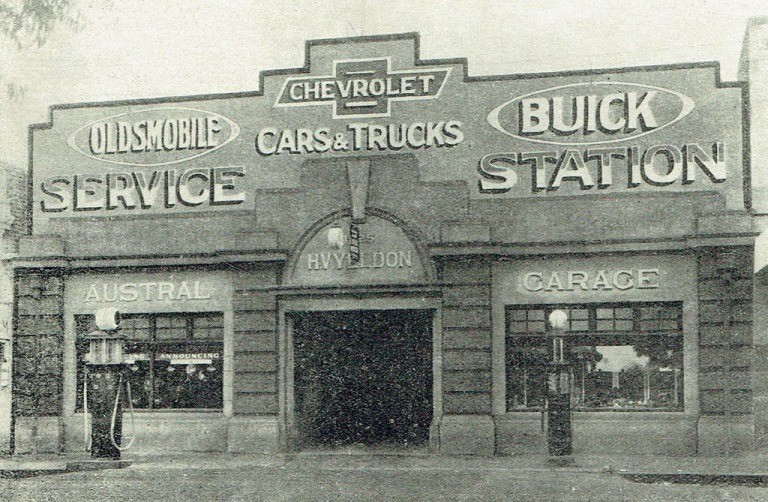
Katanning is the chief town of a district in which over 1,500 cars are registered, besides being the centre of attraction for an enormous number of travellers passing to and from the city and to the various important outlying towns. The aggregate of cars using the town for business purposes is thus very high, calling for the establishment of a thoroughly well-equipped garage with all modern facilities.
Mr. H. V. Yeldon seized the opportunity that was waiting by purchasing the Austral Motor Garage business and freehold in Austral Terrace some years ago. He added to the building and plant until it fitted his ideas of what was required. The floor space of the Austral Motor Garage is now 7,200 square feet, as compared with 1,500 when he took over the business.
The building provides behind its handsome front show rooms, offices, etc., equal to most city establishments.
As district dealer of General Motors, Mr. Yeldon holds the agency for Chevrolet, Buick and Oldsmobile cars and trucks, employing two travelling salesmen to canvas the district. The purchasing strength of the district is indicated by the fact that more than once in one month he has sold forty or more vehicles.
The accessories and spare parts department is an important adjunct to the Austral Motor Garage, and a complete range is carried, together with all makes and sizes of tyres, tubes, etc. The equipment of the Austral Motor-Garage includes: Oxy-welding plant, vulcanizing plant, duco plant, Curtiss air compressor, electric drills, lathes, cylinder-block re-boring machine, electric valve grinder, and a battery servicing department.
In August of 1928 premises were purchased at Gnowangerup and, after being renovated throughout, were fitted out as-an up-to-date garage. This branch, which affords the same conveniences as the parent business, carries a complete range of motor accessories and employs a staff of three.
The area embraced by Mr. Yeldon in his district dealership for General Motors Cars includes the districts of Nyabing, Pingrup, Woodanilling, Kojonup, Broomehill, Tambellup, Gnowangerup and Katanning.
GOLDSBROUGH, MORT & CO. LTD.
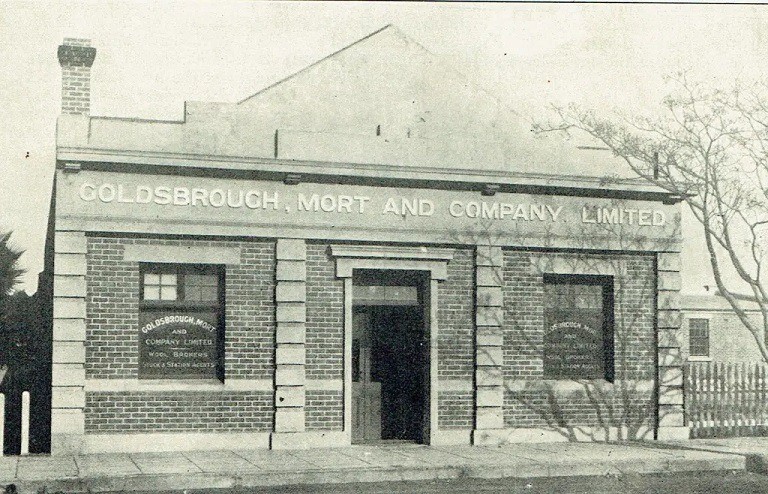
The firm of Goldsbrough, Mort and Company Limited first established itself as an independent unit in Western Australia in June, 1925, by the absorption of the business interests of Henry Wills and Company. Well known throughout the other States, its extension to Western Australia was a matter of time only, and by taking over the large pastoral and farming interests of Henry Wills and Co. it immediately secured the goodwill of these districts.
The business was continued in the Austral Terrace premises of Henry Wills and Co. Mr. F. C. Wingrove, the manager of the old firm for the Great Southern, continued in a similar capacity.
Very shortly the prestige of Goldsbrough, Mort and Co. Ltd. so added to an already flourishing business that increased office and warehouse accommodation became necessary, and in 1927, the present handsome brick premises were erected on the site of the original buildings.
At the same time provision was made for the requirements of stock by the purchase of 200 acres of land adjoining the town, plentifully watered and conveniently subdivided, as holding paddocks for stock in transit. At present, regular stock sales are held throughout the Katanning district at Katanning, Kojonup, Cranbrook, Tunney and Tambellup.
Including the manager, the staff at the Katanning branch numbers seven, all officers being well trained men. Mr. H.V. Williams, the firm’s stock- expert, is an expert of wide and varied experience, and his advice is ever in demand throughout the district.
Some estimate of the firm’s activities in the Katanning district may be gauged from the fact that during 1928 63,000 off-shears sheep were disposed of under the hammer, compared with 57,000 in 1927. The greatest number of woolled sheep sold in any one year is 60,000, making the total, both for off-shears and woolled stock, 123,000.
In keeping with its State-wide activities, Goldsbrough, Mort and Company possesses one of the largest and most up-to-date wool stores in the Commonwealth, at Fremantle, in addition to the Head Office in St. George’s Terrace, Perth.
With a staff of highly trained wool experts and ample floor space, highest current prices are always realised for wool consigned to the firm for disposal at the annual sales.
GREAT SOUTHERN HERALD
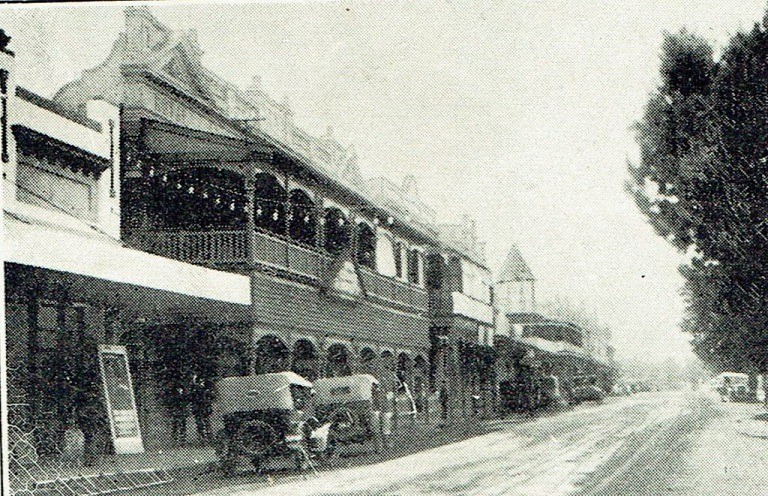
Austral Terrace, looking north showing (from left) the Lyric Theatre, Royal Exchange Hotel and “Herald” Chambers with King George Hostel in the distance..
The “Great Southern Herald”, which was established in 1901 at Katanning by Mr. Stevens, of York, under the editorship of Mr. E. Mitchell, was the first local newspaper to be published in the Great Southern districts. The paper at that time was a double-demi sheet, set by hand and printed on a Royal hand-press.
The building housing the plant being a wood and iron erection at the rear of a residence removed from the business portion of the town. The town itself was very small with a population being about 500 persons and business premises small and few and made mostly of wood and iron.
Within the next five years the paper changed hands three times with Mr. W. Bede Christie, Mr. John Tremerne, and the Hon. J. F. Cullen respectively being the proprietors. It was moved twice into new premises nearer the centre of the town, but little better in architecture. Mr. Cullen, who came from Sydney where he had long been associated with the journalistic world, continued as proprietor and owner until the time of his death in 1917.
During that time the paper grew in importance and size with the growth of the town and district. Shortly after acquiring the paper, however, it nearly came to an untimely end, as a disastrous fire in November, 1906, destroyed the block of buildings in which the business had been established. Everything was destroyed, the loss being greater in that it was not covered by insurance. Mr. Cullen, undaunted by this serious blow, hastily purchased type and machinery and, in a temporary building at the Mill, kept the publication going until new brick premises were erected by Messrs. F. and C. Piesse, the owners of the buildings which had been burned.
The “Great Southern Herald”, under his guidance, continued publication uninterruptedly in the new building until March, 1917, when death removed one to whom was due very greatly the elevation of provincial journalism throughout the State. For nine years prior to his death, the Hon. J. F. Cullen was a member in the Legislative Council for the province, first as a supporter of the Liberal Party and then as a Nationalist. On his death his widow disposed of a half interest to her son-in-law, Mr. Inglis Synnott, who became editor and manager of the business.
Although the new editor had enjoyed a good general education, which had been improved by fairly extensive travels in the old world and in the Commonwealth, he never to the slightest degree, had been in contact with journalism until he assumed control of the “Great Southern Herald”. In fact, he owned and worked a considerable farming property neat Katanning at the time. He possessed initiative and perseverance, however, and the paper soon recovered from the setback caused by the death of Mr. Cullen.
By 1923, increased business had made a change of premises necessary, and the present offices in Austral Terrace, built to the design of Mr. Synnott, were occupied. A new plant, complete in every detail, was installed at the same time, bringing the equipment thoroughly up to date.
(I have had to heavily edit the “Herald” story because it did not make a lot of sense in its original format. Ed.)
Businesses in 1929. Businesses in 1929. Businesses in 1929. Businesses in 1929. Businesses in 1929. Businesses in 1929. Businesses in 1929. Businesses in 1929. Businesses in 1929. Businesses in 1929. Businesses in 1929. Businesses in 1929.
Businesses in 1929. Businesses in 1929. Businesses in 1929. Businesses in 1929. Businesses in 1929. Businesses in 1929.
